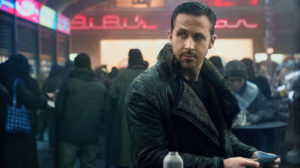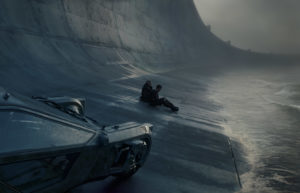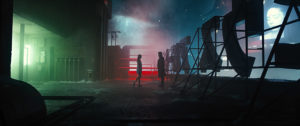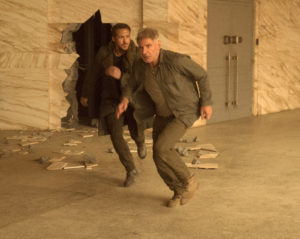By Drs. Silvia and Craig Reid
 Three decades after the events of the Ridley Scott directed Blade Runner (1982), which was made 35 years ago, Blade Runner 2049 is about LAPD Officer K (Ryan Gossling), who exhumes a long-buried past secret that could plummet what’s left of 2049’s clinging on to the quasi-life of civilization and humanity into utter anarchy and disarray. K’s discovery sends him on a quantum leap quest to find Rick Deckard (Harrison Ford), a former LAPD blade runner who’s been missing for 30 years.
Three decades after the events of the Ridley Scott directed Blade Runner (1982), which was made 35 years ago, Blade Runner 2049 is about LAPD Officer K (Ryan Gossling), who exhumes a long-buried past secret that could plummet what’s left of 2049’s clinging on to the quasi-life of civilization and humanity into utter anarchy and disarray. K’s discovery sends him on a quantum leap quest to find Rick Deckard (Harrison Ford), a former LAPD blade runner who’s been missing for 30 years.
Clocking in at 163 minutes, where you would think that the film would take forever to end or at least have needless filler scenes or dragged out sequences that big budgeted Hollywood sagas contain (Peter Jackson’s films are notorious for this; the first 45 minutes of King Kong (2005) are unnecessary), Blade Runner 2049 is over before you know it.
 Based on the Philip K. Dick novel Do Androids Dream of Electric Sheep?, the ground breaking detective, sci-fi film Blade Runner shoved audiences into the path of of 2019 dystopian future (eek, we’re almost there for real) where audiences had never seen anything like it before. One might say that The Matrix (1999) was the Blade Runner of the new millennium that challenged us with notions of possible future reality. The film also ushered in the neo-noir cyberpunk movie genre.
Based on the Philip K. Dick novel Do Androids Dream of Electric Sheep?, the ground breaking detective, sci-fi film Blade Runner shoved audiences into the path of of 2019 dystopian future (eek, we’re almost there for real) where audiences had never seen anything like it before. One might say that The Matrix (1999) was the Blade Runner of the new millennium that challenged us with notions of possible future reality. The film also ushered in the neo-noir cyberpunk movie genre.
For those curious as to how the name blade runner was created, it’s because Scott thought it sounded more cool than calling Deckard a detective. In actuality it’s a term used in a William T. Burroughs novella titled Blade Runner that he used to write a film treatment adaptation of Alan E. Nourse’s novel The Bladerunner.

In Blade Runner, Deckard (Ford) is a former blade runner, a special police squad tasked with retiring replicants, who reluctantly comes of retirement to hunt down and terminate four fugitive replicants who’ve escaped to a human colony. Replicants are superiorly strong and agile cyborgs created for slave labor that after launching a bloody mutiny were banned from Earth. The fact that the new Nexus 6 models are difficult do discern from human counterparts makes his job more dangerous. During his mission, he falls in love with Rachael, who turns out to be a replicant, which forces him to question his beliefs about replicants while confronting his own humanity. Thus for the 35 years, audiences, fans and film classes dedicated to the study of Blade Runner have all tried to figure out if Deckard is human or a replicate.
In a sense, Blade Runner 2049 is a slight play on the X-Files TV show that once weekly reiterated for almost a decade, “The truth is out there,” where in this film, “The truth is in there.”
Directed by Denis Villeneuve, Blade Runner 2049 is a brain-boggling, psyche generative force that challenges the amygdala emotional swaying with stunning visuals that awes the eyes, hallucinates the ears and forces us to re-tackle science fiction what ifs and could it happen? where perhaps the precipices of reality teeters more toward science nonfiction…and that’s creepy.
 As the film opens, it’s Los Angeles, air quality has worsened, sea levels have risen, the LA river has become so deep, so swollen and so powerful that even Schwarzenegger’s Terminator on a motor bike would perish and be washed out to the pacific ocean. To make matters worse, San Diego has become the city dump and there’s still no football team down there.
As the film opens, it’s Los Angeles, air quality has worsened, sea levels have risen, the LA river has become so deep, so swollen and so powerful that even Schwarzenegger’s Terminator on a motor bike would perish and be washed out to the pacific ocean. To make matters worse, San Diego has become the city dump and there’s still no football team down there.
On the technology front, a Nexus 9 named Luv (Sylvia Hoeks) is the latest replicant model created by a new insanely sane corporate hi-tech visionary turned agribusiness mogul Niander Wallace who wants to rule the world, to save the world and do so with creating an even more perfect replicant…perhaps she would be a Nexus 10 and nicknamed Bo. Luv is his lieutenant, a hit-cyborg that brutally kills with tears of shadowed sadness, with a hint of Malaysian martial art mayhem and thai kickboxing stomp kicks. However, no replicant warrior can measure up to those played by Rutger Hauer and Daryl Hannah in Blade Runner.
 Agent K comes home every night to pure joy, his ravishing and highly devoted live-in girlfriend Joi, commercially produced artificial intelligence. Herein lies a very subtle message that Scott weasels into the film where one may think they’re free but are really wrapped within the confines of a cage, a cage she could never escape from. It’s a notion of blurred boundaries. I won’t share how this happens, but right before each time Joi makes an appearance we hear a riff of music that was the opening music to a short-lived BBC TV show from the early 1960s, London Zoo. The zoo masters would pine for having to cage the majestic animals but understood that this may be their only chance to survive the onslaught of extinction.
Agent K comes home every night to pure joy, his ravishing and highly devoted live-in girlfriend Joi, commercially produced artificial intelligence. Herein lies a very subtle message that Scott weasels into the film where one may think they’re free but are really wrapped within the confines of a cage, a cage she could never escape from. It’s a notion of blurred boundaries. I won’t share how this happens, but right before each time Joi makes an appearance we hear a riff of music that was the opening music to a short-lived BBC TV show from the early 1960s, London Zoo. The zoo masters would pine for having to cage the majestic animals but understood that this may be their only chance to survive the onslaught of extinction.
 As an actor, Gosling almost embodies what Ford was 35 years ago, a venerable ideal of masculine cool, a guy with toughness that’s used to protect the tender soul inside. Each have the inane ability to elicit sympathy while feigning wanting it, a knack for making boredom look like passion and passion look like boredom. Quintessential gruff heroes that break the veneers of life by flexing emotional content while keeping steadfast to the self.
As an actor, Gosling almost embodies what Ford was 35 years ago, a venerable ideal of masculine cool, a guy with toughness that’s used to protect the tender soul inside. Each have the inane ability to elicit sympathy while feigning wanting it, a knack for making boredom look like passion and passion look like boredom. Quintessential gruff heroes that break the veneers of life by flexing emotional content while keeping steadfast to the self.
 The vast emptiness created by giant sets and only featuring six or seven main characters with most scenes featuring 1-3 of these actors in each shot gives the film a personable, in-depth sensibility of how lonely this world is. It’s like grasping for a straw in a needless haystack thinking you could use the straw to suck that last drop of wavering liquid from a bottle of milk you don’t have, yet you know something is missing and as you’ll see Officer K discovers it…it’s the point of the needle.
The vast emptiness created by giant sets and only featuring six or seven main characters with most scenes featuring 1-3 of these actors in each shot gives the film a personable, in-depth sensibility of how lonely this world is. It’s like grasping for a straw in a needless haystack thinking you could use the straw to suck that last drop of wavering liquid from a bottle of milk you don’t have, yet you know something is missing and as you’ll see Officer K discovers it…it’s the point of the needle.
 Though the filmmakers assert that while Blade Runner 2049 could be a sequel, Villeneuve assures that it’s a stand alone film emphasizing that K is sent on an assignment that, for very different reasons, could have more far-reaching consequences, calling into doubt the divide between people and replicants, between humanity and technology, which could also lead to anarchy or even war.
Though the filmmakers assert that while Blade Runner 2049 could be a sequel, Villeneuve assures that it’s a stand alone film emphasizing that K is sent on an assignment that, for very different reasons, could have more far-reaching consequences, calling into doubt the divide between people and replicants, between humanity and technology, which could also lead to anarchy or even war.